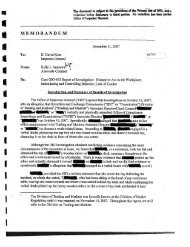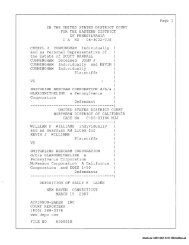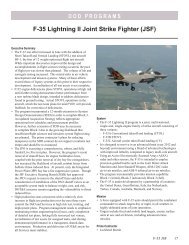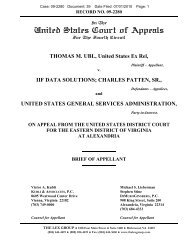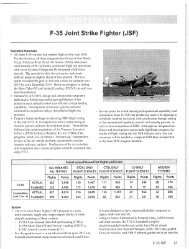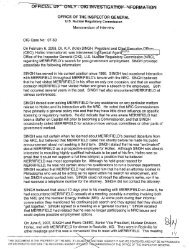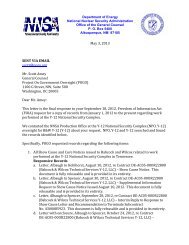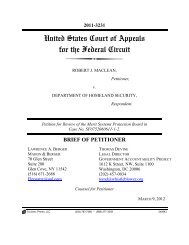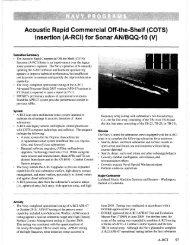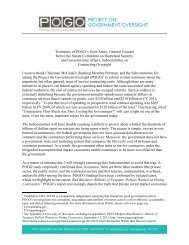F-35 Joint Strike Fighter (JSF)
F-35 Joint Strike Fighter (JSF)
F-35 Joint Strike Fighter (JSF)
You also want an ePaper? Increase the reach of your titles
YUMPU automatically turns print PDFs into web optimized ePapers that Google loves.
Executive Summary<br />
• A November 2009 Multi-Service Operational Test and<br />
Evaluation (MOT&E) demonstrated that the Teleport<br />
Generation 2. Phase 2 (G2P2) system is effective and suitable<br />
with some limitations. DoD Teleport G2P2 added military<br />
Ka-band terminals to access Wideband Global Satellites<br />
(WGS), the LinkStar Internet Protocol (IP) modem, and<br />
upgraded the software versions of the LinkWay and iDirect IP<br />
modems to use existing Teleport capabilities-<br />
• Follow-on integrated testing in April 201)) demonstrated that<br />
the program manager corrected a power control problem with<br />
the iDirect IP Version-7 modem observed during the MOT& E.<br />
• The Milestone Decision Authority granted the Defense<br />
Information Systems Agency (DISA) the authority to enter<br />
Teleport Generation 3, Phase I (G3P 1 ) into the Production and<br />
Deployment Phase. Teleport (BPI will integrate Advanced<br />
Extremely High Frequency (A EHF) Extended Data Rate<br />
(X DR) capability into the existing Teleport system Extremely<br />
High Frequency (EHF) architecture.<br />
System<br />
• DoD Teleport sites are globally distributed satellite<br />
Communications (SATCOM) facilities- The system has six<br />
core Teleport facilities located in Virginia, Germany, Italy,<br />
Japan, Hawaii, and California. Teleport sites consist of four<br />
segments:<br />
The radio frequency segment consists of SATCOM earth<br />
terminals that operate in X-, C-. Ku-, Ka-. Ultra High<br />
Frequency (UHF), and EHF bands- The terminals provide<br />
radio frequency links between the Teleport site and the<br />
deployed user SATCOM terminal via commercial or<br />
military satellites.<br />
The Teleport base-band segment includes encryption,<br />
switching, multiplexing, and routing functions for<br />
connecting data streams or packetized data to the Defense<br />
Information Systems Network (DISN)-<br />
- The network services segment provides connectivity to the<br />
DISN long-haul networks and data conversion functions<br />
necessary to meet the user's requirements-<br />
Activity<br />
• The <strong>Joint</strong> Interoperability Test Command (JITC) conducted<br />
the G2P2 MOT&E November 2009 at the Hawaii DoD<br />
Teleport site and the Pacific Theater Network Operations<br />
Center (TNC) at Wheeler Army Air Field, Hawaii- Eleven<br />
operational units along with a special LinkStar unit operated<br />
from deployed locations in California, Oklahoma, Arizona,<br />
Idaho, Hawaii, and Korea.<br />
Teleport<br />
- The management control segment provides centralized<br />
monitoring and control of Teleport base-band hardware,<br />
SATCOM earth terminal hardware, transmission security,<br />
and test equipment.<br />
Mission<br />
• Combatant Commanders, Services, and deployed operational<br />
forces use Teleport systems in all phases or conflict to gain<br />
worJdwide military and commercial SATCOM services-<br />
• "Teleport provides deployed forces access to standard fixed<br />
gateways from anywhere in the world for all six DISN<br />
services:<br />
- Secret Internet Protocol Router Network (SIPRNet)<br />
- Non-secure Internet Protocol Router Network (NIPRNet)<br />
Defense Red Switch Network (DRSN)<br />
Defense Switched Network (DSN)<br />
Video Teleconferences (VTC)<br />
<strong>Joint</strong> Worldwide Intelligence Communications System<br />
(JWICS)<br />
Major Contractor<br />
Government Integrator DISA<br />
• The MOT&E focused on Teleport's capability to provide<br />
deployed users Ka-band access, DISN services using three<br />
different current force IP modem variants, and the system<br />
control and management capability.<br />
• JITC and the program office conducted a follow-on test at<br />
the Wahiawa Teleport in April 2010 to verify correction of a<br />
Teleport 43



